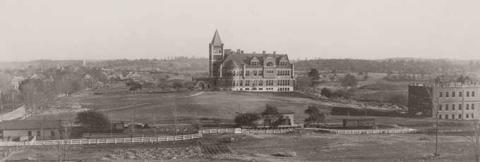
February 23 - July 16, 2001
Dale Valena, Museum Curator
Through a chronological display of photos, text, and artifacts, this exhibit told the story of the formative years of New Hampshire's land-grant college, built for the benefit of all of the people of the state. The exhibit covered the early development of UNH before it was in Durham and before it was incorporated as a university.
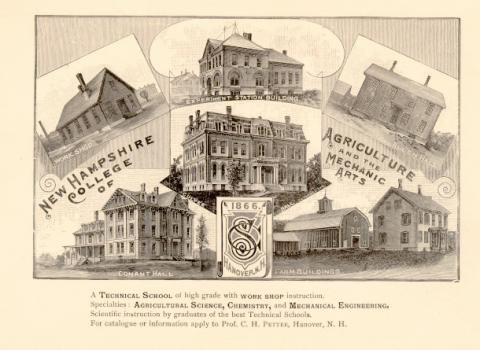
An early recruiting poster, ca. 1888
Competition for students was keen among all colleges in the 1870s and 1880s. For new and untried institutions like the Agricultural College, securing students was even more of a problem. Professors Pettee and Scott spent their summer vacations traveling the countryside by horse and buggy and talking to prospective students wherever they might be found.
Colleges founded in this country before the Revolutionary War were the special province of the privileged classes, offering a strictly classical program of study.
The industrial revolution, with its flood of new inventions and increasingly complex technology, created a demand for workers possessing a technical education beyond that available at a secondary level. Even more important in an overwhelmingly agricultural society was the need for advanced agricultural education and research.
To read more about significant events in the history of the New Hampshire College of Agriculture and the Mechanic Arts, view the Chronology 1856-1893.
The Morrill Act
The Morrill Act of 1862, introduced by Senator Justin S. Morrill of Vermont, called for the federal government to provide each state with a grant of land that could be sold
… for the endowment, support, and maintenance of at least one college where the leading object shall be, without excluding other scientific and classical studies, and including military tactics, to teach such branches of learning as are related to agriculture and the mechanic arts
The act further stipulated that none of the money could be used for buildings; each state had to provide its own physical facilities.
On July 7, 1866, Governor Frederick Smyth signed a bill providing for the incorporation of the New Hampshire College of Agriculture and the Mechanic Arts. The new college was to be established in Hanover in order to share the resources of Dartmouth College. Each institution, however, was to retain their separate identities.
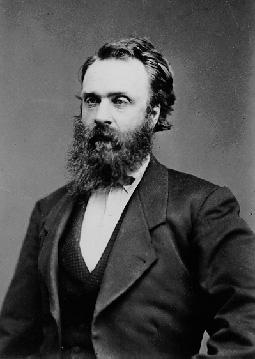
Ezekiel Dimond
"If any man can be called the father of the college, Ezekiel W. Dimond is the man." - Donald Babcock, UNH Historian
Ezekiel Dimond was elected by the Board of Trustees to serve as the first professor of the College of Agriculture and the Mechanic Arts. He arrived in Hanover on August 1, 1868, bringing with him seven boxes of books, specimens, and equipment - the entire physical property of a college that really existed only on paper.
But Prof. Dimond was a man of unlimited vision and determination. From 1868 until his untimely death in 1876 at age forty, he taught the general and agricultural chemistry courses and also served as the business manager, recruiter, architect, supervisor of construction, farm manager, and lobbyist in the legislature.
On his death, the trustees stated, "Without Dimond's zeal, faith, and personal labor on behalf of an enterprise that absorbed all his time and thought, it is believed by many that the College would today be a vagary of the mind, rather than an accomplished fact."
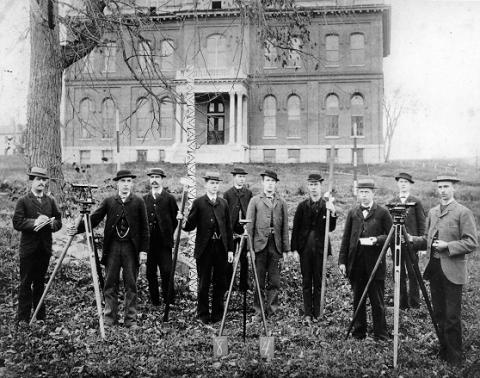
Class of 1884 in front of Culver Hall, 1881
From left to right: Edwin C. Thompson, Moses B. Mann, Ernest S. Comings, Herbert H. Kimball, Alton A. Gile, William Adams, Sylvester M. Foster, Fred C. Davis, James W. Cuthbert, George M. Moore
David Culver
General David Culver, a successful businessman from Lyme, New Hampshire, took an active interest in the new college. In his will he left his farm and $30,000 to promote agricultural education. These funds made possible the construction of the college's first building. Culver Hall, opened in 1871, housed the chemical laboratory, classrooms, and museum.
The school's curriculum developed as the mission of the college solidified. Students in the first classes could choose to study either Agriculture or the Mechanic Arts. By the last years in Hanover, there were four courses of study: Agriculture, Chemistry, Mechanical Engineering, and Electrical Engineering. A General Course was added when it became evident that women were interested in attending the college.
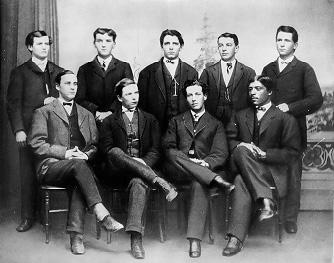
This photograph shows nine of the first ten students to register when the college opened in 1868. Only two returned for the second year, and they, with the addition of a third man, went on to graduate as the Class of 1871.
The Class of 1871
"Like all pioneers, for that is what we were, we had a variety of experiences not found in the 'curriculum'. Putting ten country boys in more or less proximity to 300 regular college boys was not calculated to promote much enthusiasm among the 'bucolic' as we were called. Oh yes, we had another rather pungent appellation, 'dungists'. Now with these names there was absolutely no possibility of our being mistaken for any of the high-brow students, although we many have been equal in horse-sense." - C. A. Wilcomb, Class of 1871
Charles H. Hood
Charles H. Hood was the sole member of the NHC class of 1880 in Hanover. After graduation, he joined his father's dairy business and was soon president of H.P. Hood & Sons Milk Co. Charles Hood was an enthusiastic alumnus and a generous benefactor to the new college in Durham.
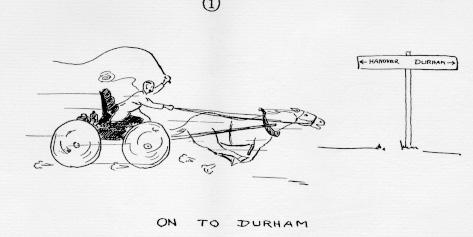
Cartoon of Dean Charles Pettee by unknown student, ca. 1934
From Hanover to Durham
Over the years, relations between Dartmouth and the New Hampshire College became increasingly strained. The college was denounced by Dartmouth as being too "aggie." At the same time, the Granges were criticizing it for not putting enough focus on the agricultural program.
In 1885 the state legislature appointed a committee to investigate the feasibility of moving the New Hampshire College to a new location. But it was not until 1890, when Benjamin Thompson died and his will became public that the dream of moving out from under the shadow of Dartmouth became a reality.

Benjamin Thompson, 1806-1890
Benjamin Thompson, a farmer and a highly competent business man, was born in Durham on April 22, 1806. He never married and when he was fifty years old, he wrote a will leaving his farm and assets totalling over $400,000, to the state of New Hampshire for the establishment of an agricultural college on his land in Durham. Six year later, the Morrill Act would facilitate the installation of just such a college in Hanover.
For the next thirty-four years, Thompson quietly tended his farm and watched what transpired in Hanover. Although it is clear that his original intention was the establishment of a school exclusively for teaching agriculture, in 1874 he added a codicil to his will extending the scope of the college to include the mechanic arts.
Benjamin Thompson died on January 30, 1890, and in 1891 the state legislature voted to accept the provisions of the Thompson will and to move the college from Hanover to Durham, establishing the foundation for the University of New Hampshire and the fulfillment of Ben Thompson's dream.
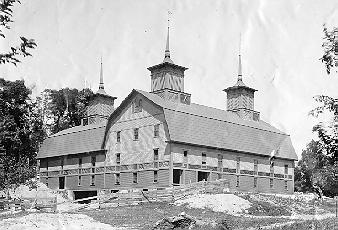
The original college barn for the Durham campus, designed by George H. Whitcher, director of the Agricultural Experiment Station, was a model of the latest theories and practices in agriculture. However, local farmers were wary of the grandiose structure that they said was "fixed up as nice, outside and in, as our houses are" and they soon dubbed it 'Whitcher's Folly.' It burned down in 1894 and was replaced by a less extravagant building.
The First Graduation in Durham
"In May, 1892, Professor Pettee approached the members of the '92 Class and informed them that the corner stone of Thompson Hall was to be laid soon at Durham with appropriate ceremonies, and he would like to have our graduating exercises as part of the program.
We left Hanover in the morning of the selected date, arriving at Durham a little before noon and went directly to the barn. There we were served our alumni dinner on the second floor. At 1 o'clock we gathered at the site of the corner stone at the front left-hand corner of Thompson Hall. Soon after we gathered, a sudden heavy shower was pelting us, so we made a hasty retreat back to the barn, it being the nearest and only building on the campus.
After taking a good look at the class and the layout of the lower floor, Prof. Pettee decided to back us into the corner of the calf pen and present us with our diplomas as part of the exercises." - Edward M. Stone, Class of 1892